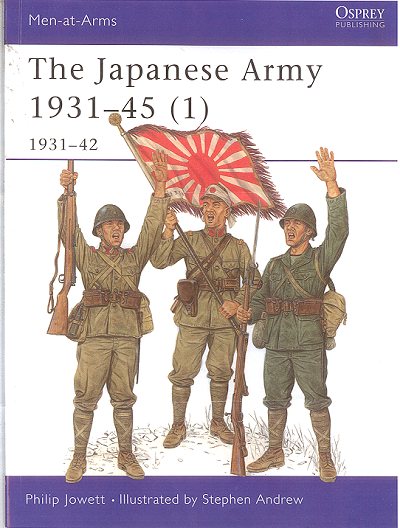 Price:
$14.95 (may vary)
Price:
$14.95 (may vary)|
BOOK |
Japanese Army 1931-45 vol 1 |
|
BY: |
Philip Jowett |
|
PUBLISHER |
Osprey |
|
REVIEW BY: |
|
|
NOTES: |
Men at Arms series #362 |
 Price:
$14.95 (may vary)
Price:
$14.95 (may vary)
Pros: Updated subject matter; good text, excellent drawing, charts, & photos
Cons: Volume 1 of 2-volume set, may be out of some people’s price ranges
Last month, I reviewed a reprint of an early Osprey book, a 1-volume work of the Japanese Army of WW2. In that review, I mentioned that Osprey was planning a 2-volume updated series on that very subject. The first volume has arrived. These questions must be asked: is this a significant improvement over other material; is it of the quality of current Osprey works; does this add to our knowledge base? The answer to all of those is YES.
This first volume covers the period 1931-42. It is amazing to see how many detail changes Japanese Army uniforms went through in 11 short years. The author rightly points out that the Japanese Army was more or less in continuous conflict from 1931 to 1945. Therefore, the evolution from a post-WW 1-style army to a WW-2 style army is shown in this work. For example, the photos and plates show five different helmets in use during this period! The differences between the Army and Naval Landing Forces are shown, with the different color of the NLF uniforms and detail differences clearly outlined. (Also, the Army’s Rising Sun flag had the red circle in the center of the flag, while the NLF Rising Sun flag had the red circle offset to one side.)
The text carries a good, though necessarily brief, overview of Japanese operations during 1931-42, and then analyzes uniforms, headgear, footwear, weaponry, specialist clothing, and the like. There are excellent color plates in the current exact Osprey style and good explanations of those plates in the back of the book.
In short, this book is worth it. Its companion volume, covering the years 1942-45, will be released this spring. The only drawback is that it is a two-volume set, and the necessity to purchase BOTH books for completeness may put it out of range for some purchasers. The earlier volume from 1971, reprinted late last year, is still worth having and I see the earlier volume and this current set as complementary, not competitive. I assume that Vol. 2 will be of the same quality as this one, so both will be worth purchasing.
Review courtesy of me & my wallet!
Comments: BobShoop@aol.com